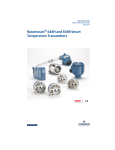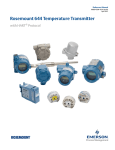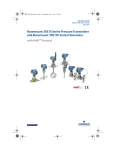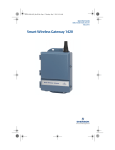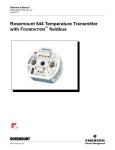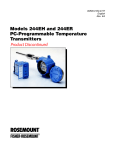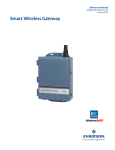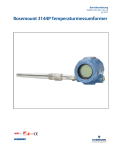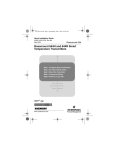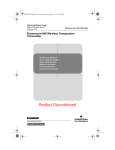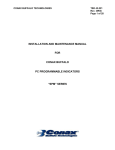Download Emerson 644 Instruction manual
Transcript
Quick Start Guide 00825-0200-4728, Rev DB February 2015 Rosemount 644 Temperature Transmitter with 4-20 mA HART® (Revision 5 and 7) Protocol Note Before installing the transmitter, confirm the correct device driver is loaded on the host systems. See page 3 for System Readiness. Quick Start Guide February 2015 NOTICE This guide provides basic guidelines for Rosemount 644 transmitters. It does not provide instructions for configuration, diagnostics, maintenance, service, troubleshooting, Explosion-proof, Flameproof, or intrinsically safe (I.S.) installations. Refer to the Rosemount 644 Reference Manual (document number 00809-0100-4728) for more instruction. This manual is also available electronically on www.rosemount.com. Explosions could result in death or serious injury. Installation of this transmitter in an explosive environment must be in accordance with the appropriate local, national, and international standards, codes, and practices. Please review the approvals section of the 644 reference manual for any restrictions associated with a safe installation. Before connecting a HART-based communicator in an explosive atmosphere, make sure the instruments in the loop are installed in accordance with intrinsically safe or non-incendive field wiring practices. Electrical shock can result in death or serious injury. Avoid contact with the leads and the terminals. High voltage that may be present on leads can cause electrical shock. Conduit/cable entries Unless marked, the conduit/cable entries in the transmitter housing use a 1/2-14 NPT thread form. Entries marked “M20” are M20 ⫻ 1.5 thread form. On devices with multiple conduit entries, all entries will have the same thread form. Only use plugs, adapters, glands, or conduit with a compatible thread form when closing these entries. When installing in a Hazardous Location, use only appropriately listed or Ex certified plugs, adapters, or glands in cable/conduit entries. Contents System readiness . . . . . . . . . . . . . . . . . . . . . . . 3 Transmitter installation . . . . . . . . . . . . . . . . . 4 Set the alarm switch . . . . . . . . . . . . . . . . . . . . 4 Verify configuration . . . . . . . . . . . . . . . . . . . . . 5 Mount the transmitter . . . . . . . . . . . . . . . . . 10 2 Wire and apply power . . . . . . . . . . . . . . . . . . 13 Perform a loop test . . . . . . . . . . . . . . . . . . . . 18 Safety instrumented systems . . . . . . . . . . 19 Product Certifications . . . . . . . . . . . . . . . 20 Quick Start Guide February 2015 System readiness Confirm HART revision capability If using HART based control or asset management systems, please confirm the HART capability of those systems prior to transmitter installation. Not all systems are capable of communicating with HART Revision 7 protocol. This transmitter can be configured for either HART Revision 5 or 7. For instructions on how to change the HART revision of your transmitter, see “Verify configuration” on page 5. Confirm correct device driver Verify the latest Device Driver files are loaded on your systems to ensure proper communications. Download the latest Device Driver at http://www.emersonprocess.com.en-US/documentation/deviceinstallkits/Pa ges/AboutDeviceInstallKits.aspx or http://www.hartcomm.org/protocol/products/products.html Rosemount 644 device revisions and files Table 1 provides the information necessary to ensure you have the correct Device Driver files and Documentation for your device. Table 1. Rosemount 644 Device Revisions and Files Software date Identify device Date NAMUR software revision HART software revision June 2012 1.1.1 01 Find device driver files HART universal revision(1) Device revision(2) 5 8 7 9 Review instructions Review functionality Manual document number Changes to software (3) 00809-0100-4728 See Footnote 3 for list of changes. 1. NAMUR Software Revision is located on the hardware tag of the device. HART Software Revision can be read using a HART communication tool. 2. Device Driver file names use Device and DD Revision, e.g. 10_01. HART Protocol is designed to enable legacy device driver revisions to continue to communicate with new HART devices. To access new functionality, the new Device Driver must be downloaded. It is recommended to download new Device Driver files to ensure full functionality. 3. HART Revision 5 and 7 Selectable, Dual Sensor support, Safety Certified, Advanced Diagnostics (if ordered), Enhanced Accuracy and Stability (if ordered). 3 February 2015 Quick Start Guide Transmitter installation Step 1: Set the alarm switch Set the 644 alarm switch before putting the device into operation. Without an LCD display: 1. Set the loop to manual (if applicable) and disconnect the power. 2. Remove the housing cover. 3. Set the switch to the desired position (H indicates High, L indicates Low), then reattach the housing cover. 4. Apply power and set the loop to automatic control. Figure 1. Placement of Alarm Switch 644 Transmitter 644 Field Mount A A. Alarm Switch Note If using an LCD display, first remove the pink foam spacer located between the LCD and cover. The spacer can be discarded. Next, remove the display by detaching it from the top of the device, set the switch to the desired position and reattach the LCD display. 4 February 2015 Quick Start Guide Step 2: Verify configuration Verify the configuration of the Rosemount 644 device upon receiving your transmitter using any HART compliant configuration tool. See the Rosemount 644 Reference Manual (document number 00809-0200-4728) for configuration instructions using AMS® Device Manager. The 644 communicates using the Field Communicator (communication requires a loop resistance between 250 and 1100 ohms). Do not operate when power is below 12 Vdc at the transmitter terminal. See the 644 Reference Manual (document number 00809-0200-4728) and Field Communicator Reference Manual for more information. Verify configuration with a Field Communicator A Rosemount 644 DD (device descriptor) must be installed on the Field Communicator to verify the configuration. Fast Key sequences for the latest DD are shown in Table on page 6. For Fast Key sequences using legacy DD's, contact your local Emerson Process Management representative. Perform the following steps to determine if an upgrade is required. 1. Connect the sensor (see the wiring diagram located on the device’s top label). 2. Connect the bench power supply to the power terminals (“+” or “–”). 3. Connect a Field Communicator to the loop across a loop resistor or at the power/signal terminals on the transmitter. 4. The following message will appear if the communicator has a previous version of the DDs: Device Description Not Installed…The Device Description for manufacturer 0x26 model 0x2618 dev rev 8/9 is not installed on the System Card…see Programming Utility for details on Device Description updates…Do you wish to proceed in forward compatibility mode? If this notice does not appear, the latest DD is installed. If the latest version is not available, the communicator will communicate properly, however, when the transmitter is configured to utilize the advanced features of the transmitter, the user will experience trouble communicating and will be prompted to turn the communicator off. To prevent this from happening, upgrade to the latest DD or answer NO to the question and default to the generic transmitter functionality. Note Emerson recommends installing the latest DD to access the complete functionality. Visit www.fieldcommunicator.com for information on updating the DD Library. Field Communicator user interface Two user interfaces are available to configure this device. The Device Revision 8 and 9 (HART 5 and 7), DD Revision 1 Fast Key Sequence in Table 2 may be used for transmitter configuration and startup. 5 February 2015 Quick Start Guide Figure 2. Device Dashboard Field Communicator Interface Table 2. Device Revision 8 and 9 (HART 5 and 7), DD Revision 1 Fast Key Sequence Function HART 5 HART 7 Alarm Values 2, 2, 5, 6 2, 2, 5, 6 3, 4, 5 3, 4, 5 Analog Output 2, 2, 5, 1 2, 2, 5, 1 Average Temperature Setup 2, 2, 3, 3 2, 2, 3, 3 Burst Mode 2, 2, 8, 4 2, 2, 8, 4 Comm Status N/A 1, 2 Configure additional messages N/A 2, 2, 8, 4, 7 2, 2, 4, 1, 3 2, 2, 4, 1, 3 D/A Trim 3, 4, 4, 1 3, 4, 4, 1 Damping Values 2, 2, 1, 5 2, 2, 1, 6 2, 2, 7, 1, 2 2, 2, 7, 1, 3 2, 1, 4 2, 1, 4 2, 2, 7, 1, 4 2, 2, 7, 1, 5 1, 8, 1 1, 8, 1 Differential Temperature Setup 2, 2, 3, 1 2, 2, 3, 1 Drift Alert 2, 2, 4, 2 2, 2, 4, 2 2, 2, 7, 4, 1 2, 2, 7, 4, 1 First Good Temperature Setup 2, 2, 3, 2 2, 2, 3, 2 Hardware Revision 1, 8, 2, 3 1, 8, 2, 3 N/A 2, 2, 9, 2 2, 2, 7, 4, 2 2, 2, 7, 4, 2 Analog Calibration Configure Hot Backup™ Date Display Setup Descriptor Device Information Filter 50/60 Hz HART Lock Intermittent Sensor Detect 6 Quick Start Guide February 2015 Table 2. Device Revision 8 and 9 (HART 5 and 7), DD Revision 1 Fast Key Sequence Function HART 5 HART 7 Loop Test 3, 5, 1 3, 5, 1 Locate Device N/A 3, 4, 6, 2 Lock Status N/A 1, 8, 3, 8 LRV (Lower Range Value) 2, 2, 5, 5, 3 2, 2, 5, 5, 3 LSL (Lower Sensor Limit) 2, 2, 1, 7, 2 2, 2, 1, 8, 2 Message 2, 2, 7, 1, 3 2, 2, 7, 1, 4 Open Sensor Holdoff 2, 2, 7, 3 2, 2, 7, 3 Percent Range 2, 2, 5, 2 2, 2, 5, 2 Sensor 1 Configuration 2, 1, 1 2, 1, 1 Sensor 2 Configuration 2, 1, 1 2, 1, 1 Sensor 1 Serial Number 2, 2, 1, 6 2, 2, 1, 7 Sensor 2 Serial Number 2, 2, 2, 7 2, 2, 2, 8 Sensor 1 Type 2, 2, 1, 2 2, 2, 1, 3 Sensor 2 Type 2, 2, 2, 2 2, 2, 2, 3 Sensor 1 Unit 2, 2, 1, 4 2, 2, 1, 5 Sensor 2 Unit 2, 2, 2, 4 2, 2, 2, 5 Sensor 1 Status N/A 2, 2, 1, 2 Sensor 2 Status N/A 2, 2, 2, 2 Simulate Digital Signal N/A 3, 5, 2 1, 8, 2, 4 1, 8, 2, 4 2, 2, 7, 1, 1 2, 2, 7, 1, 1 N/A 2, 2, 7, 1, 2 2, 2, 7, 1 2, 2, 8, 1 URV (Upper Range Value) 2, 2, 5, 5, 2 2, 2, 5, 5, 2 USL (Upper Sensor Limit) 2, 2, 1, 7, 2 2, 2, 1, 8, 2 Variable Mapping 2, 2, 8, 5 2, 2, 8, 5 2-wire Offset Sensor 1 2, 2, 1, 9 2, 2, 1, 10 2-wire Offset Sensor 2 2, 2, 2, 9 2, 2, 2, 10 Software Revision Tag Long Tag Terminal Temperature 7 February 2015 Quick Start Guide Input or verify Callendar Van-Dusen constants If sensor matching is being used with this combination of a transmitter and sensor, verify the constants input. 1. From the HOME screen, select 2 Configure, 2 Manual Setup, 1 Sensor. 2. Set the control loop to manual and select OK. 3. At the ENTER SENSOR TYPE prompt, select Cal VanDusen. 4. At the ENTER SENSOR CONNECTION prompt, select the appropriate number of wires. 5. Enter the Ro, Alpha, Delta, and Beta values from the stainless steel tag attached to the special-order sensor when prompted. 6. Return the control loop to automatic control and select OK. 7. To disable the transmitter-sensor matching feature from the HOME screen select 2 Configure, 2 Manual Setup, 1 Sensor, 10 SensorMatching-CVD. 8. Choose the appropriate sensor type from the ENTER SENSOR TYPE prompt. Verifying configuration with Local Operator Interface (LOI) The optional LOI can be used for commissioning the device. The LOI is a two button design. To activate the LOI, push any button. LOI button functionality is shown on the bottom corners of the display. See Table 3 and Figure 4 for button operation and menu information. Figure 3. Local Operator Interface Table 3. LOI Button Operation Button 8 Left No SCROLL Right Yes ENTER February 2015 Quick Start Guide Figure 4. LOI Menu Switch HART revision mode Not all systems are capable of communicating with HART Revision 7 protocol. This transmitter can be configured for either HART Revision 5 or 7 using a HART capable configuration tool. Updated configuration menus include a HART Universal Revision parameter that can be configured to 5 or 7 if accessible by your system. See Table 2 for the Fast Key sequence. If the HART configuration tool is not capable of communicating with HART Revision 7, the configuration menus in Table 2 will not be available. To switch the HART Universal Revision parameter from generic mode, follow the instructions below. 1. Go to Configure>Manual Setup>Device Information>Identification>Message. a. To change your device to HART Revision 7, Enter: “HART7” in the Message field. b. To change your device to HART Revision 5, Enter: “HART5” in the Message field. Note See Table 2 on page 6 to change HART revision when the correct Device Driver is loaded. 9 February 2015 Quick Start Guide Step 3: Mount the transmitter Mount the transmitter at a high point in the conduit run to prevent moisture from draining into the transmitter housing. Head mount transmitter with DIN plate style sensor installation 1. Attach the thermowell to the pipe or process container wall. 2. Install and tighten the thermowell before applying process pressure. 3. Verify the transmitter failure mode switch position. 4. Assemble the transmitter to the sensor. Push the transmitter mounting screws through the sensor mounting plate. 5. Wire the sensor to the transmitter (see “Wire and apply power” on page 13). 6. Insert the transmitter-sensor assembly into the connection head. a. Thread the transmitter mounting screw into the connection head mounting holes. b. Assemble the extension to the connection head. c. Insert the assembly into the thermowell. 7. If using a cable gland, properly attach the cable gland to a housing conduit entry. 8. Insert the shielded cable leads into the connection head through the cable entry. 9. Connect the shielded power cable leads to the transmitter power terminals. Avoid contact with sensor leads and sensor connections. 10. Connect and tighten the cable gland. 11. Install and tighten the connection head cover. Enclosure covers must be fully engaged to meet explosion-proof requirements. A B D E A. Connection head cover B. Connection head C. Thermowell 10 C F D. Transmitter mounting screws E. Integral mount sensor with flying leads F. Extension Quick Start Guide February 2015 Head mount transmitter with threaded sensor installation (2 or 3 conduit entries) 1. Attach the thermowell to the pipe or process container wall. 2. Install and tighten thermowells before applying process pressure. 3. Attach necessary extension nipples and adapters to the thermowell. 4. Seal the nipple and adapter threads with silicone tape. 5. Screw the sensor into the thermowell. Install drain seals if required for severe environments or to satisfy code requirements. 6. Verify the transmitter failure mode switch is in the desired position. 7. To verify the correct installation of Integral Transient Protection (option code T1) on the 644 device, confirm the following steps have been completed: a. Ensure the transient protector unit is firmly connected to the transmitter puck assembly. b. Ensure the transient protector power leads are adequately secured under the transmitter power terminal screws. c. Verify the transient protector’s ground wire is secured to the internal ground screw found within the universal head. Note The transient protector requires the use of an enclosure of at least 3.5-in. (89 mm) in diameter. 8. Pull the sensor wiring leads through the universal head and transmitter center hole. 9. Mount the transmitter in the universal head by threading the transmitter mounting screws into the universal head mounting holes. 10. Mount the transmitter-sensor assembly into the thermowell, or remote mount if desired. 11. Seal adapter threads with silicone tape. 12. Pull the field wiring leads through the conduit into the universal head. Attach the sensor and power leads to the transmitter. Avoid contact with other terminals. 13. Install and tighten the universal head cover. Enclosure covers must be fully engaged to meet explosion-proof requirements. A B D C E A. Threaded thermowell B. Threaded style sensor C. Standard extension D. Universal head (transmitter inside) E. Conduit entry 11 February 2015 Quick Start Guide Field mount transmitter with threaded sensor installation 1. Attach the thermowell to the pipe or process container wall. Install and tighten thermowells before applying process pressure. 2. Attach necessary extension nipples and adapters to the thermowell. 3. Seal the nipple and adapter threads with silicone tape. 4. Screw the sensor into the thermowell. Install drain seals if required for severe environments or to satisfy code requirements. 5. Verify the transmitter failure mode switch is in the desired position. 6. Mount the transmitter-sensor assembly into the thermowell, or remote mount if desired. 7. Seal adapter threads with silicone tape. 8. Pull the field wiring leads through the conduit into the field mount housing. Wire the sensor and power leads to the transmitter. Avoid contact with other terminals. 9. Install and tighten the covers of two compartments. Enclosure covers must be fully engaged to meet explosion-proof requirements. A D B C E A. Threaded thermowell B. Threaded style sensor C. Standard extension 12 D. Field mount housing (transmitter inside) E. Conduit entry Quick Start Guide February 2015 Step 4: Wire and apply power Wire the sensor to the transmitter The wiring diagram is located on the device’s top label below the terminal screws. 644 Head Mount Transmitter Figure 5. 644 Head Mount - Single and Dual Input Wiring Diagrams *The transmitter must be configured for at least a 3-wire RTD in order to recognize an RTD with a compensation loop. ** Rosemount Inc. provides a 4-wire sensors for all single element RTDs. Use these RTDs in 3-wire configurations by leaving the unneeded leads disconnected and insulated with electrical tape. 13 February 2015 Quick Start Guide 644 Field Mount Transmitter Figure 6. 644 Field Mount - Single and Dual Input Wiring Diagrams Power the transmitter An external power supply is required to operate the transmitter. 1. Remove the housing cover (if applicable). 2. Connect the positive power lead to the “+” terminal. Connect the negative power lead to the “–” terminal. - If a transient protector is being used, the power leads will now be connected to the top of the transient protector unit. See the transient label for indication of “+” and “-“terminal connections. 3. Tighten the terminal screws. When tightening the sensor and power wires, the max torque is 6 in.-lbs (0.7 N-m). 4. Reattach and tighten the cover (if applicable). 5. Apply power (12 – 42 Vdc). 14 Quick Start Guide February 2015 Load limitation The power required across the transmitter power terminals is 12 to 42.4 Vdc (the power terminals are rated to 42.4 Vdc). To prevent damaging the transmitter, do not allow terminal voltage to drop below 12.0 Vdc when changing the configuration parameters. Ground the transmitter To ensure proper grounding, it is important that the instrument cable shield be: trimmed close and insulated from touching the transmitter housing connected to the next shield if cable is routed through a junction box connected to a good earth ground at the power supply end Note Shielded twisted pair cable should be used for best results. Use 24 AWG or larger wire and do not exceed 5,000 feet (1500 meters). Ungrounded thermocouple, mV, and RTD/Ohm inputs Each process installation has different requirements for grounding. Use the grounding options recommended by the facility for the specific sensor type, or begin with grounding Option 1 (the most common). Option 1 1. Connect sensor wiring shield to the transmitter housing. 2. Ensure the sensor shield is electrically isolated from surrounding fixtures that may be grounded. 3. Ground signal wiring shield at the power supply end. B A C DCS D A. Sensor wires B. Transmitter C. Shield ground point D. 4-20 mA loop 15 February 2015 Quick Start Guide Option 2 1. Connect signal wiring shield to the sensor wiring shield. 2. Ensure the two shields are tied together and electrically isolated from the transmitter housing. 3. Ground shield at the power supply end only. 4. Ensure the sensor shield is electrically isolated from the surrounding grounded fixtures. B A C DCS D A. Sensor wires B. Transmitter C. Shield ground point D. 4-20 mA loop 5. Connect shields together, electrically isolated from the transmitter. Option 3 1. Ground sensor wiring shield at the sensor, if possible. 2. Ensure the sensor wiring and signal wiring shields are electrically isolated from the transmitter housing. 3. Do not connect the signal wiring shield to the sensor wiring shield. 4. Ground signal wiring shield at the power supply end. B A C DCS D A. Sensor wires B. Transmitter 16 C. Shield ground point D. 4-20 mA loop Quick Start Guide February 2015 Grounded thermocouple inputs Option 1 1. Ground sensor wiring shield at the sensor. 2. Ensure the sensor wiring and signal wiring shields are electrically isolated from the transmitter housing. 3. Do not connect the signal wiring shield to the sensor wiring shield. 4. Ground signal wiring shield at the power supply end. B A C DCS D A. Sensor wires B. Transmitter C. Shield ground point D. 4-20 mA loop 17 February 2015 Quick Start Guide Step 5: Perform a loop test The Loop Test command verifies transmitter output, loop integrity, and operation of any recorders or similar devices installed in the loop. Performing a loop test using a Field Communicator Initiate a loop test 1. Connect an external ampere meter in series with the transmitter loop (so the power to the transmitter goes through the meter at some point in the loop). 2. From the home screen, enter the Fast Key sequence. Device dashboard Fast Keys 3, 5, 1 3. In the test loop, check that the transmitter’s actual mA output and the HART mA reading are the same value. If the readings do not match, either the transmitter requires an output trim or the meter is malfunctioning. After completing the test, the display returns to the loop test screen and allows the user to choose another output value. 4. To end the Loop Test, select End and Enter. Performing a loop test using AMS Device Manager 1. Right click on the device and select Service Tools. 2. In the left navigation pane select Simulate. 3. On the Simulate Tab in the Analog Output Verification group box, select the Perform Loop Test button. 4. Follow the guided instructions and select Apply when complete. Performing a loop test using the Local Operator Interface Reference the figure below to find the path to the Loop Test in the LOI menu. Figure 7. Configuring the Tag with LOI 18 February 2015 Quick Start Guide Safety instrumented systems For Safety Certified installations, refer to the Rosemount 644 Reference Manual (document number 00809-0200-4728). The manual is available electronically at www.rosemount.com or by contacting an Emerson Process Management representative. 19 Quick Start Guide February 2015 Product Certifications European Directive Information A copy of the EC Declaration of Conformity can be found at the end of the Quick Start Guide. The most recent revision of the EC Declaration of Conformity can be found at www.rosemount.com. Ordinary Location Certification from FM Approvals As standard, the transmitter has been examined and tested to determine that the design meets the basic electrical, mechanical, and fire protection requirements by FM Approvals, a nationally recognized test laboratory (NRTL) as accredited by the Federal Occupational Safety and Health Administration (OSHA). Installing Equipment in North America The US National Electrical Code (NEC) and the Canadian Electrical Code (CEC) permit the use of Division marked equipment in Zones and Zone marked equipment in Divisions. The markings must be suitable for the area classification, gas, and temperature class. his information is clearly defined in the respective codes. USA E5 FM Explosionproof, Non-Incendive, Dust-Ignitionproof Certificate: [XP & DIP]: 3006278; [NI]: 3008880 & 3044581 Standards: FM Class 3600: 2011, FM Class 3615: 2006, FM Class 3616: 2011, FM Class 3810: 2005, NEMA-250: 250: 2003, ANSI/IEC 60529: 2004 Markings: XP CL I, DIV 1, GP B, C, D; DIP CL II / III, GP E, F, G; (-50 °C ≤ Ta ≤ +85 °C); Type 4X; See I5 description for Non-Incendive markings I5 FM Intrinsic Safety and Non-Incendive Certificate: 3008880 [Headmount Fieldbus/PROFIBUS®, Railmount HART] Standards: FM Class 3600: 1998, FM Class 3610: 2010, FM Class 3611: 2004, FM Class 3810: 2005, NEMA – 250: 1991 Markings: IS CL I / II / III, DIV I, GP A, B, C, D, E, F, G; NI CL I, DIV 2, GP A, B, C, D; Special Conditions for Safe Use (X): 1. When no enclosure option is selected, the Model 644 Temperature Transmitter shall be installed in an enclosure meeting the requirements of ANSI/ISA S82.01 and S82.03 or other applicable ordinary location standards. 2. Option code K5 is only applicable with Rosemount J5 Universal Head (M20⫻1.5) or Rosemount J6 Universal Head (1/2-14 NPT) enclosure. 3. An enclosure options must be selected to maintain a Type 4X rating. 20 February 2015 Quick Start Guide Certificate: 3044581 [Headmount HART] Standards: FM Class 3600: 2011, FM Class 3610: 2010, FM Class 3611: 2004, FM Class 3810: 2005, ANSI/NEMA – 250: 1991; ANSI/IEC 60529: 2004; ANSI/ISA 60079-0: 2009; ANSI/ISA 60079-11: 2009 Markings: [No Enclosure]: IS CL I, DIV I, GP A, B, C, D T4; CL I ZONE 0 AEx ia IIC T4 Ga; NI CL I, DIV 2, GP A, B, C, D T5 [With Enclosure]: IS CL I / II / III, DIV 1, GP A, B, C, D, E, F, G; NI CL I, DIV 2, GP A, B, C, D Special Conditions for Safe Use (X): 1. When no enclosure option is selected, the Model 644 Temperature Transmitter shall be installed in a final enclosure meeting type of protection IP20 and meeting the requirements of ANSI/ISA 61010-1 and ANSI/ISA 60079-0. 2. The Model 644 optional housings may contain aluminum and is considered a potential risk of ignition by impact or friction. Care must be taken during installation and use to prevent impact and friction. Canada I6 CSA Intrinsic Safety and Division 2 Certificate: 1091070 Standards: CAN/CSA C22.2 No. 0-M10, CSA Std C22.2 No. 25-1966, CAN/CSAC22.2 No. 94-M91, CSA Std C22.2 No. 142-M1987, CAN/CSA-C22.2 No. 157-92, CSA Std C22.2 No. 213-M1987, C22.2 No 60529-05 Markings: [HART] IS CL I GP A, B, C, D T4/T6; CL I, ZONE 0 IIC; CL I, DIV 2, GP A, B, C, D [Fieldbus/PROFIBUS] IS CL I GP A, B, C, D T4; CL I, ZONE 0 IIC; CL I, DIV 2, GP A, B, C, D K6 CSA Explosionproof, Dust-Ignitionproof, Intrinsic Safety and Division 2 Certificate: 1091070 Standards: CAN/CSA C22.2 No. 0-M10, CSA Std C22.2 No. 25-1966, CSA Std. C22.2 No. 30-M1986, CAN/CSA-C22.2 No. 94-M91, CSA Std C22.2 No. 142-M1987, CAN/CSA-C22.2 No. 157-92, CSA Std C22.2 No. 213-M1987, C22.2 No 60529-05 Markings: CL I / II / III, DIV 1, GP B, C, D, E, F, Gh See I6 description for Intrinsic Safety and Division 2 markings Europe E1 ATEX Flameproof Certificate: FM12ATEX0065X Standards: EN 60079-0: 2012, EN 60079-1: 2007, EN 60529:1991 +A1:2000 Markings: II 2 G Ex d IIC T6…T1 Gb, T6(-50 °C ≤ Ta ≤ +40 °C), T5…T1(-50 °C ≤ Ta ≤ +60 °C); See Table 4 for Process Temperatures. Special Conditions for Safe Use (X): 1. See certificate for ambient temperature range. 2. The non-metallic label may store an electrostatic charge and become a source of ignition in Group III environments. 3. Guard the LCD cover against impact energies greater than 4 joules. 4. Consult the manufacturer if dimensional information on the flameproof joints is necessary. 21 Quick Start Guide February 2015 I1 ATEX Intrinsic Safety Certificate: [Headmount HART]: Baseefa12ATEX0101X [Headmount Fieldbus/PROFIBUS]: Baseefa03ATEX0499X [Railmount HART]: BAS00ATEX1033X Standards: EN 60079-0: 2012, EN 60079-11: 2012 Markings: [HART]: III 1 G Ex ia IIC T6…T4 Ga; [Fieldbus/PROFIBUS]: II 1 G Ex ia IIC T4 Ga; See Table 5 for Entity Parameters and Temperature Classifications. Special Conditions for Safe Use (X): 1. The equipment must be installed in an enclosure which affords it a degree of protection of at least IP20 in accordance with the requirements of IEC 60529. Non-metallic enclosures must have a surface resistance of less than 1GΩ; light alloy or zirconium enclosures must be protected from impact and friction when installed in a Zone 0 environment. 2. When fitted with the Transient Protector Assembly, the equipment is not capable of withstanding the 500 V test as defined in Clause 6.3.13 of EN 60079-11:2012. This must be taken into account during installation. N1 ATEX Type n – with enclosure Certificate: BAS00ATEX3145 Standards: EN 60079-0:2012, EN 60079-15:2010 Markings: II 3 G Ex nA IIC T5 Gc (-40 °C ≤ Ta ≤ +70 °C) NC ATEX Type n – no enclosure Certificate: [Headmount Fieldbus/PROFIBUS, Railmount HART]: Baseefa13ATEX0093X [Headmount HART]: Baseefa12ATEX0102U Standards: EN60079-0:2012, EN60079-15:2010 Markings: [Headmount Fieldbus/PROFIBUS, Railmount HART]: II 3 G Ex nA IIC T5 Gc (-40 °C ≤ Ta ≤ +70 °C) [Headmount HART]: II 3 G Ex nA IIC T6…T5 Gc; T6(-60 °C ≤ Ta ≤ +40 °C); T5(-60 °C ≤ Ta ≤ +85 °C) Special Conditions for Safe Use (X): 1. The Model 644 Temperature Transmitter must be installed in a suitably certified enclosure such that it is afforded a degree of protection of at least IP54 in accordance with IEC 60529 and EN 60079-15. 2. When fitted with the Transient Protector Assembly, the equipment is not capable of withstanding the 500 V test. This must be taken into account during installation. ND ATEX Dust Certificate: FM12ATEX0065X Standards: EN 60079-0: 2012, EN 60079-31: 2009, EN 60529:1991 +A1:2000 Markings: II 2 D Ex tb IIIC T130 °C Db, (-40 °C ≤ Ta ≤ +70 °C); IP66 See Table 4 for Process Temperatures. Special Conditions for Safe Use (X): 1. See certificate for ambient temperature range. 2. The non-metallic label may store an electrostatic charge and become a source of ignition in Group III environments. 3. Guard the LCD cover against impact energies greater than 4 joules. 4. Consult the manufacturer if dimensional information on the flameproof joints is necessary. 22 February 2015 Quick Start Guide International E7 IECEx Flameproof Certificate: IECEx FMG 12.0022X Standards: IEC 60079-0:2011, IEC 60079-1:2007-04, IEC 60079-31:2008 Markings: Ex d IIC T6…T1 Gb, T6(-50 °C ≤ Ta ≤ +40 °C), T5…T1(-50 °C ≤ Ta ≤ +60 °C); See Table 4 for Process Temperatures. Special Conditions for Safe Use (X): 1. See certificate for ambient temperature range. 2. The non-metallic label may store an electrostatic charge and become a source of ignition in Group III environments. 3. Guard the LCD cover against impact energies greater than 4 joules. 4. Consult the manufacturer if dimensional information on the flameproof joints is necessary. I7 IECEx Intrinsic Safety Certificate: [Headmount HART]: IECEx BAS 12.0069X [Headmount Fieldbus/PROFIBUS, Railmount HART]: IECEx BAS 07.0053X Standards: IEC 60079-0: 2011; IEC 60079-11: 2011 Markings: Ex ia IIC T6…T4 Ga See Table 5 for Entity Parameters and Temperature Classifications. Special Conditions for Safe Use (X): 1. The equipment must be installed in an enclosure which affords it a degree of protection of at least IP20 in accordance with the requirements of IEC 60529. Non-metallic enclosures must have a surface resistance of less than 1GΩ; light alloy or zirconium enclosures must be protected from impact and friction when installed in a Zone 0 environment. 2. When fitted with the Transient Protector Assembly, the equipment is not capable of withstanding the 500 V test as defined in Clause 6.3.13 of IEC 60079-11:2011. This must be taken into account during installation. N7 IECEx Type n – with enclosure Certificate: IECEx BAS 07.0055 Standards: IEC 60079-0:2011, IEC 60079-15:2010 Markings: Ex nA IIC T5 Gc; T5(-40 °C ≤ Ta ≤ +70 °C) NG IECEx Type n – no enclosure Certificate: [Headmount Fieldbus/PROFIBUS, Railmount HART]: IECEx BAS 12.0053X [Headmount HART]: IECEx BAS 12.0070U Standards: IEC 60079-0:2011, IEC 60079-15:2010 Markings: [Headmount Fieldbus/PROFIBUS, Railmount HART]: Ex nA IIC T5 Gc (-40 °C ≤ Ta ≤ +70 °C) [Headmount HART]: Ex nA IIC T6…T5 Gc; T6(-60 °C ≤ Ta ≤ +40 °C); T5(-60 °C ≤ Ta ≤ +85 °C) Special Conditions for Safe Use (X): 1. The Model 644 Temperature Transmitter must be installed in a suitably certified enclosure such that it is afforded a degree of protection of at least IP54 in accordance with IEC 60529 and IEC 60079-15. 2. When fitted with the Transient Protector Assembly, the equipment is not capable of withstanding the 500 V test. This must be taken into account during installation. 23 Quick Start Guide February 2015 NK IECEx Dust Certificate: IECEx FMG 12.0022X Standards: IEC 60079-0: 2011, IEC 60079-31: 2008 Markings: Ex tb IIIC T130 °C Db, (-40 °C ≤ Ta ≤ +70 °C); IP66; See Table 4 for Process Temperatures. Special Conditions for Safe Use (X): 1. See certificate for ambient temperature range. 2. The non-metallic label may store an electrostatic charge and become a source of ignition in Group III environments. 3. Guard the LCD cover against impact energies greater than 4 joules. 4. Consult the manufacturer if dimensional information on the flameproof joints is necessary. Brazil E2 INMETRO Flameproof Certificate: NCC 12.1147X Standards: ABNT NBR IEC 60079-0:2008, ABNT NBR IEC 60079-1:2009, NBR 8094:1983 Markings: Ex d IIC T6…T1 (-40 °C ≤ Ta ≤ +65 °C) Gb; IP66W Special Conditions for Safe Use (X): 1. Care must be taken to ensure that the surface temperature does not exceed 85 °C when RTDs or thermocouples are fitted to the transmitter. 2. The mechanical and chemical characteristics of the process fluid must be evaluated in order not to cause deterioration or corrosion to the temperature probes. 3. For information on the dimensions of explosion-proof joints, the manufacturer should be contacted. I2 INMETRO Intrinsic Safety Certificate: CEPEL 02.0096X Standards: ABNT NBR IEC 60079-0:2008, ABNT NBR IEC 60079-11:2009, ABNT NBR IEC 60079-26:2008, ABNT NBR IEC 60529:2009 Markings: Ex ia IIC T* Ga IP66W See Table 5 for Entity Parameters and Temperature Classifications. Special Conditions for Safe Use (X): 1. The apparatus must be installed in an enclosure which affords it a degree of protection of at least IP20. 2. Light allow or zirconium enclosures must be protected from impact and friction when installed. 3. When the maximum ambient temperature at the place of installation is greater than 50 °C, the equipment shall be installed with adequate insulation cables the minimum temperature of 90 °C. 24 Quick Start Guide February 2015 China E3 China Flameproof Certificate: GYJ111385 Standards: GB3836.1-2000, GB3836.2-2000, GB12476.1-2000 Markings: Ex d IIC T6 Special Conditions of Use (X): 1. Temperature Assembly using temperature sensor type 65, 68, 75, 183, 185 are certified. 2. The ambient temperature range is: Gas/Dust Ambient temperature Gas -40 °C ≤ Ta ≤ +65 °C Dust -40 °C ≤ Ta ≤ +85 °C 3. The earth connection facility in the enclosure should be connected reliably. 4. During installation, use and maintain in explosive gas atmospheres, observe the warning “Do not open when energized”. During installation, use and maintain in explosive dust atmosphere, observe the warning “Do not open when an explosive dust atmosphere is present”. 5. During installation, there should be no mixture harmful to flameproof housing. 6. During installation in hazardous location, cable glands, conduits and blanking plugs, certified by state-appointed inspection bodies with Ex d II C, DIP A20 IP66 degree, should be used. 7. Maintenance should be done in a non-hazardous location. 8. During installation, use and maintain in explosive dust atmosphere, product enclosure should be cleaned to avoid dust accumulation, but compressed air should not be used. 9. End users is not permitted to change any components inside, but to settle the problem in conjunction with manufacturer to avoid damage to the product. 10. During installation, use and maintenance of this product, observe the following standards: GB3836.13-1997 “Electrical apparatus for explosive gas atmospheres Part 13: Repair and overhaul for apparatus used in explosive gas atmospheres” GB3836.15-2000 “Electrical apparatus for explosive gas atmospheres Part 15: Electrical installations in hazardous area (other than mines)” GB3836.16-2006 “Electrical apparatus for explosive gas atmospheres Part 16: Inspection and maintenance of electrical installation (other than mines)” GB50257-1996 “Code for construction and acceptance of electric device for explosion atmospheres and fire hazard electrical equipment installation engineering”. GB15577-1995 “Safe regulation for explosive dust atmospheres” GB12476.2-2006 “Electrical apparatus for use in the presence of combustible dust Part 1-2: Electrical apparatus protected by enclosures and surface temperature limitation-Selection, installation and maintenance” 25 February 2015 Quick Start Guide I3 China Intrinsic Safety Certificate: GYJ111384X Standards: GB3836.1-2000, GB3836.4-2000 Markings: Ex ia IIC T4/T5/T6 Special Conditions for Safe Use (X): 1. The ambient temperature range is: When Options do not select Enhance Performance Transmitter output Maximum input power: (W) T code Ambient temperature 0.67 T6 -60 °C ≤ Ta ≤ +40 °C 0.67 T5 -60 °C ≤ Ta ≤ +50 °C 1 T5 -60 °C ≤ Ta ≤ +40 °C A 1 T4 -60 °C ≤ Ta ≤ +80 °C 1.3 T4 -50 °C ≤ Ta ≤ +60 °C 5.32 T4 -50 °C ≤ Ta ≤ +60 °C F or W When Options select Enhanced Performance Maximum input power: (W) T code Ambient temperature 0.67 T6 -60 °C ≤ Ta ≤ +40 °C 0.67 T5 -60 °C ≤ Ta ≤ +50 °C 0.80 T5 -60 °C ≤ Ta ≤ +40 °C 0.80 T4 -60 °C ≤ Ta ≤ +80 °C 2. Parameters: When Options do not select Enhanced Performance Terminals of power supply (+, -) Transmitte r output Maximum input voltage: Ui (V) Maximum input current: Ii (mA) Maximum input power: Pi (W) Maximum internal parameters: Ci (nF) Li(mH) A 30 200 0.67/1 10 0 F, W 30 300 1.3 2.1 0 F,W (FISCO) 17.5 380 5.32 2.1 0 Maximum output voltage: Uo (V) Maximum output current: Io (mA) Maximum output power: Po (W) Co (nF) Lo(mH) A 13.6 80 0.08 75 0 F, W 13.9 23 0.079 7.7 0 Terminals of sensor (1,2,3,4) Transmitte r output 26 Maximum internal parameters: Quick Start Guide February 2015 When Options select Enhanced Performance Terminals of power supply (+, -) Maximum input voltage: Ui (V) Maximum input current: Ii (mA) Maximum internal parameters: Maximum input power: Pi (W) Ci (nF) Li(mH) 3.3 0 150 (Ta ≤ +80 °C) 30 170 (Ta ≤ +70 °C) 0.67 / 0.8 190 (Ta ≤ +60 °C) Terminals of sensor (1,2,3,4) Maximum output voltage: Uo (V) Maximum output current: Io (mA) Maximum output power: Po (W) Gas group IIC 13.6 80 0.08 Maximum internal parameters: Co (nF) Lo(mH) 0.816 5.79 IIB 5.196 23.4 IIA 18.596 48.06 3. This product complies to the requirements for FISCO field devices specified in IEC60079–27: 2008. For the connection of an intrinsically safe circuit in accordance FISCO model, FISCO parameters of this product are as above. 4. The product should be used with Ex-certified associated apparatus to establish explosion protection system that can be used in explosive gas atmospheres. Wiring and terminals should comply with the instruction manual of the product and associated apparatus. 5. The cables between this product and associated apparatus should be shielded cables (the cables must have insulated shield). The shielded has to be grounded reliably in non-hazardous area. 6. End users are not permitted to change any components insides, but to settle the problem in conjunction with manufacturer to avoid damage to the product. 7. During installation, use and maintenance of this product, observe the following standards: GB3836.13-1997 “Electrical apparatus for explosive gas atmospheres Part 13: Repair and overhaul for apparatus used in explosive gas atmospheres” GB3836.15-2000 “Electrical apparatus for explosive gas atmospheres Part 15: Electrical installations in hazardous area (other than mines)” GB3836.16-2006 “Electrical apparatus for explosive gas atmospheres Part 16: Inspection and maintenance of electrical installation (other than mines)” GB50257-1996 “Code for construction and acceptance of electric device for explosion atmospheres and fire hazard electrical equipment installation engineering” 27 February 2015 Quick Start Guide N3 China Type n Certificate: GYJ101421 Standards: GB3836.1-2000, GB3836.8-2003 Markings: Ex nA nL IIC T5/T6 Special Conditions for Safe Use (X): 1. The relation among T code, ambient temperature range is as following: When Options do not select Enhanced Performance: T code Ambient temperature T5 -40 °C ≤ Ta ≤ +70 °C When Options select Enhanced Performance: T code Ambient temperature T6 -60 °C ≤ Ta ≤ +40 °C T5 -60 °C ≤ Ta ≤ +85 °C 2. Maximum input voltage: 42.4V. 3. Cable glands, conduit or blanking plugs, certified by NEPSI with Ex e or Ex n protection type and appropriate thread type and IP54 degree, should be used on external connections and redundant cable entries. 4. Maintenance should be done in non-hazardous location. 5. End users are not permitted to change any components inside, but to settle the problem in conjunction with manufacturer to avoid damage to the product. 6. During installation, use and maintenance of this product, observe the following standards: GB3836.13-1997 “Electrical apparatus for explosive gas atmospheres Part 13: Repair and overhaul for apparatus used in explosive gas atmospheres” GB3836.15-2000 “Electrical apparatus for explosive gas atmospheres Part 15: Electrical installations in hazardous area (other than mines)” GB3836.16-2006 “Electrical apparatus for explosive gas atmospheres Part 16: Inspection and maintenance of electrical installation (other than mines)” GB50257-1996 “Code for construction and acceptance of electric device for explosion atmospheres and fire hazard electrical equipment installation engineering” EAC - Belarus, Kazakhstan, Russia EM Technical Regulation Customs Union (EAC) Flameproof Certificate: RU C-US.GB05.B.00289 Standards: GOST R IEC 60079-0-2011, GOST IEC 60079-1-2011 Markings: 1Ex d IIC T6…T1 Gb X, T6(-50 °C ≤ Ta ≤ +40 °C), T5…T1(-50 °C ≤ Ta ≤ +60 °C); IP65/IP66/IP68 Special Condition for Safe Use (X): 1. See certificate for special conditions. IM Technical Regulation Customs Union (EAC) Intrinsic Safety Certificate: RU C-US.GB05.B.00289 Standards: GOST R IEC 60079-0-2011, GOST R IEC 60079-11-2010 Markings: [HART]: 0Ex ia IIC T4…T6 Ga X; [Fieldbus/PROFIBUS]: 0Ex ia IIC T4 Ga X Special Condition for Safe Use (X): 1. See certificate for special conditions. 28 February 2015 Quick Start Guide Japan E4 Japan Flameproof Certificate: TC20671 [J2 with LCD], TC20672 [J2], TC20673 [J6 with LCD], TC20674 [J6] Markings: Ex d IIC T5 Combinations K1 Combination of E1, I1, N1, and ND K2 Combination of E2 and I2 K5 Combination of E5 and I5 K7 Combination of E7, I7, and N7 KA Combination of K6, E1, and I1 KB Combination of K5 and K6 KC Combination of I5 and I6 KD Combination of E5, I5, K6, E1, and I1 KM Combination of EM and IM Additional Certifications SBS American Bureau of Shipping (ABS) Type Approval Certificate: 11-HS771994A-1-PDA ABS Rules: 2013 Steel Vessels Rules 1-1-4/7.7, 1-1-Appendix 3, 4-8-3/1.7, 4-8-3/13.1 SBV Bureau Veritas (BV) Type Approval Certificate: 26325/A2 BV Requirements: Bureau Veritas Rules for the Classification of Steel Ships Application: Class notations: AUT-UMS, AUT-CCS, AUT-PORT and AUT-IMS SDN Det Norske Veritas (DNV) Type Approval Certificate: A-13246 Intended Use: Det Norske Veritas’ Rules for Classification of Ships, High Speed & Light Craft and Det Norske Veritas’ Offshore Standards Application: Location Classes: Temperature: D; Humidity: B; Vibration: A; EMC: B; Enclosure: B/IP66: A, C/IP66: SST SLL Lloyds Register (LR) Type Approval Certificate: 11/60002 Application: For use in environmental categories ENV1, ENV2, ENV3 and ENV5. 29 February 2015 Quick Start Guide Table 4. Process Temperatures Maximum ambient T6 T5 T4 T3 T2 T1 T130 +40 °C +60 °C +60 °C +60 °C +60 °C +60 °C +70 °C Sensor extension Transmitter with LCD display 0-in. 55 °C 70 °C 95 °C 95 °C 95 °C 95 °C 95 °C 3-in. 55 °C 70 °C 100 °C 100 °C 100 °C 100 °C 100 °C 6-in. 60 °C 70 °C 100 °C 100 °C 100 °C 100 °C 100 °C 9-in. 65 °C 75 °C 110 °C 110 °C 110 °C 110 °C 110 °C Transmitter without LCD display 0-in. 55 °C 70 °C 100 °C 170 °C 280 °C 440 °C 100 °C 3-in. 55 °C 70 °C 110 °C 190 °C 300 °C 450 °C 110 °C 6-in. 60 °C 70 °C 120 °C 200 °C 300 °C 450 °C 110 °C 9-in. 65 °C 75 °C 130 °C 200 °C 300 °C 450 °C 120 °C Table 5. Entity Parameters Fieldbus/PROFIBUS HART HART (Enhanced) Ui (V) 30 30 30 Ii (mA) 300 200 150 for Ta ≤ +80 °C 170 for Ta ≤ +70 °C 190 for Ta ≤ +60 °C Pi (W) 1.3 @ T4 (-50 °C ≤ Ta ≤ +60 °C) .67 @ T6 (-60 °C ≤ Ta ≤ +40 °C) .67 @ T5 (-60 °C ≤ Ta ≤ +50 °C) 1.0 @ T5 (-60 °C ≤ Ta ≤ +40 °C) 1.0 @ T4 (-60 °C ≤ Ta ≤ +80 °C) .67 @ T6 (-60 °C ≤ Ta ≤ +40 °C) .67 @ T5 (-60 °C ≤ Ta ≤ +50 °C) .80 @ T5 (-60 °C ≤ Ta ≤ +40 °C) .80 @ T4 (-60 °C ≤ Ta ≤ +80 °C) Ci (nF) 2.1 10 3.3 Li (mH) 0 0 0 30 February 2015 Quick Start Guide Figure 8. EC Declaration of Conformity for 644 Temperature Transmitter 31 Quick Start Guide 32 February 2015 February 2015 Quick Start Guide 33 Quick Start Guide 34 February 2015 February 2015 Quick Start Guide 35 00825-0200-4728 Quick Start Guide 00825-0200-4728, Rev DB February 2015 Rosemount World Headquarters Emerson Process Management 6021 Innovation Blvd Shakopee, MN 55379, USA +1 800 999 9307 or +1 952 906 8888 +1 952 949 7001 [email protected] North America Regional Office Emerson Process Management 8200 Market Blvd. Chanhassen, MN 55317, USA +1 800 999 9307 or +1 952 906 8888 +1 952 949 7001 [email protected] Latin America Regional Office Emerson Process Management 1300 Concord Terrace, Suite 400 Sunrise, Florida, 33323, USA +1 954 846 5030 +1 954 846 5121 [email protected] Europe Regional Office Emerson Process Management Europe GmbH Neuhofstrasse 19a P.O. Box 1046 CH 6340 Baar Switzerland +41 (0) 41 768 6111 +41 (0) 41 768 6300 [email protected] Asia Pacific Regional Office Emerson Process Management Asia Pacific Pte Ltd 1 Pandan Crescent Singapore 128461 +65 6777 8211 +65 6777 0947 [email protected] Middle East and Africa Regional Office Emerson Process Management Emerson FZE P.O. Box 17033, Jebel Ali Free Zone - South 2 Dubai, United Arab Emirates +971 4 8118100 +971 4 8865465 [email protected] Standard Terms and Conditions of Sale can be found at: www.rosemount.com\terms_of_sale. AMS and the Emerson logo are registered trademarks and service marks of Emerson Electric Co. Rosemount and Rosemount logotype are registered trademarks of Rosemount Inc. Hot Backup is a trademark of Rosemount Inc. HART is a registered trademark of the HART Communication Foundation. PROFIBUS is a registered trademark of PROFINET International (PI). All other marks are the property of their respective owners. © 2015 Rosemount Inc. All rights reserved.





































